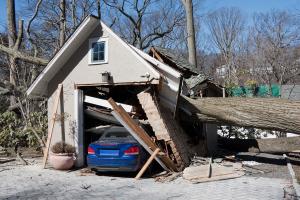Not just auto maintenance — auto safety

Cars these days are pretty complex. But, sometimes, things as simple as a roll of paper towels, or a tire pressure gauge, can prove valuable for keeping your car safe on the roads.
Here are some safety-enhancing auto maintenance tips you can start today – and should start doing routinely.
Lights: It is to your benefit — and that of other drivers — that all of your cars lights are functioning properly. However, just because they turn on doesn’t mean they are providing optimal visibility. As a rule of thumb, each time you are washing your windows at a gas station, give your head and taillights a quick squeegee, too.
Our partners at CARFAX have several additional tips to ensure you’re getting the most out of your headlights.
Tires: Drivers often underestimate the importance of properly inflated tires. In fact, according to the National Highway Traffic Safety Association, just 19% of drivers keep their tires properly inflated. Ensuring proper inflation routinely can help you stay safe on the roads, and prolong the life of your tires as well. We have some more tips on keeping your tires roadworthy.
Fluids: The long-accepted rule for oil changes is 3,000 miles. However, if you drive a newer car, you may be able to go longer (consult your owner’s manual). Nonetheless, checking your oil at least once a month is recommended no matter how new your car is (this can be paired up with your tire inflation check).
And, when it does come time to change your oil, make sure to have vital fluids checked as well, including power-steering, automatic transmission, wiper, and brake fluids.
In winter climates:
Keep your wipers up and off your windshield as a storm approaches, and don’t use them to attempt to remove snow and ice. Make sure your windshield is completely cleared off before using the wipers. These steps will help you avoid damage to the motor that runs the wipers.
For defrosting windows, start on a low setting and gradually work the temperature higher, to avoid unnecessary stress and shock to the cold glass.
Brakes: Brakes often let you know when they need a little attention, and not just when the “brakes” light is illuminated on your dashboard. If your car pulls to the left or right, or you hear squeaking or grinding, it’s time to get your brakes checked, sooner rather than later.
In winter climates:
Keep your wipers up and off your windshield as a storm approaches, and don’t use them to attempt to remove snow and ice. Make sure your windshield is completely cleared off before using the wipers. These steps will help you avoid damage to the motor that runs the wipers.
For defrosting windows, start on a low setting and gradually work the temperature higher, to avoid unnecessary stress and shock to the cold glass.
Windows and mirrors: Fog causes more than 25,000 car crashes per year. There’s not much you can do about that (other than drive with extra caution), but that statistic helps illustrate the impact that poor visibility can have on road safety.
Steps you can take? Maintain maximum visibility by keeping your mirrors and windows clean (inside and out). Keep in mind, too, that keeping a clean windshield will also prolong the life of your wipers.
Regular check-ups: You don’t have to know much about cars to diagnose potential problems such as a sludgy engine, or a loose battery cable. Make sure to occasionally pop the hood and take a look around – if something looks amiss, take it to experts to address any issues you may find, if you don’t feel comfortable doing it yourself.
More complex maintenance tasks are best left to people with the tools and expertise. Make sure to schedule tune-ups in accordance to your owner’s manual, to inspect exhaust, flush the cooling system, and replace frayed or cracking valves and hoses, and inspect brakes. Routine maintenance will keep your care safe – and moving.
Staying safe – on the road and off
One place you can turn for additional auto protection is your independent insurance agent. They can review your policy and help keep your coverage up to date. Make this conversation part of your annual auto maintenance routine.
Not just auto maintenance — auto safety
Cars these days are pretty complex. But, sometimes, things as simple as a roll of paper towels, or a tire pressure gauge, can prove valuable for keeping your car safe on the roads.
Here are some safety-enhancing auto maintenance tips you can start today – and should start doing routinely.
Lights: It is to your benefit — and that of other drivers — that all of your cars lights are functioning properly. However, just because they turn on doesn’t mean they are providing optimal visibility. As a rule of thumb, each time you are washing your windows at a gas station, give your head and taillights a quick squeegee, too.
Our partners at CARFAX have several additional tips to ensure you’re getting the most out of your headlights.
Tires: Drivers often underestimate the importance of properly inflated tires. In fact, according to the National Highway Traffic Safety Association, just 19% of drivers keep their tires properly inflated. Ensuring proper inflation routinely can help you stay safe on the roads, and prolong the life of your tires as well. We have some more tips on keeping your tires roadworthy.
Fluids: The long-accepted rule for oil changes is 3,000 miles. However, if you drive a newer car, you may be able to go longer (consult your owner’s manual). Nonetheless, checking your oil at least once a month is recommended no matter how new your car is (this can be paired up with your tire inflation check).
And, when it does come time to change your oil, make sure to have vital fluids checked as well, including power-steering, automatic transmission, wiper, and brake fluids.
In winter climates:
Keep your wipers up and off your windshield as a storm approaches, and don’t use them to attempt to remove snow and ice. Make sure your windshield is completely cleared off before using the wipers. These steps will help you avoid damage to the motor that runs the wipers.
For defrosting windows, start on a low setting and gradually work the temperature higher, to avoid unnecessary stress and shock to the cold glass.
Brakes: Brakes often let you know when they need a little attention, and not just when the “brakes” light is illuminated on your dashboard. If your car pulls to the left or right, or you hear squeaking or grinding, it’s time to get your brakes checked, sooner rather than later.
In winter climates:
Keep your wipers up and off your windshield as a storm approaches, and don’t use them to attempt to remove snow and ice. Make sure your windshield is completely cleared off before using the wipers. These steps will help you avoid damage to the motor that runs the wipers.
For defrosting windows, start on a low setting and gradually work the temperature higher, to avoid unnecessary stress and shock to the cold glass.
Windows and mirrors: Fog causes more than 25,000 car crashes per year. There’s not much you can do about that (other than drive with extra caution), but that statistic helps illustrate the impact that poor visibility can have on road safety.
Steps you can take? Maintain maximum visibility by keeping your mirrors and windows clean (inside and out). Keep in mind, too, that keeping a clean windshield will also prolong the life of your wipers.
Regular check-ups: You don’t have to know much about cars to diagnose potential problems such as a sludgy engine, or a loose battery cable. Make sure to occasionally pop the hood and take a look around – if something looks amiss, take it to experts to address any issues you may find, if you don’t feel comfortable doing it yourself.
More complex maintenance tasks are best left to people with the tools and expertise. Make sure to schedule tune-ups in accordance to your owner’s manual, to inspect exhaust, flush the cooling system, and replace frayed or cracking valves and hoses, and inspect brakes. Routine maintenance will keep your care safe – and moving.
Staying safe – on the road and off
One place you can turn for additional auto protection is your independent insurance agent. They can review your policy and help keep your coverage up to date. Make this conversation part of your annual auto maintenance routine.
Not just auto maintenance — auto safety
Cars these days are pretty complex. But, sometimes, things as simple as a roll of paper towels, or a tire pressure gauge, can prove valuable for keeping your car safe on the roads.
Here are some safety-enhancing auto maintenance tips you can start today – and should start doing routinely.
Lights: It is to your benefit — and that of other drivers — that all of your cars lights are functioning properly. However, just because they turn on doesn’t mean they are providing optimal visibility. As a rule of thumb, each time you are washing your windows at a gas station, give your head and taillights a quick squeegee, too.
Our partners at CARFAX have several additional tips to ensure you’re getting the most out of your headlights.
Tires: Drivers often underestimate the importance of properly inflated tires. In fact, according to the National Highway Traffic Safety Association, just 19% of drivers keep their tires properly inflated. Ensuring proper inflation routinely can help you stay safe on the roads, and prolong the life of your tires as well. We have some more tips on keeping your tires roadworthy.
Fluids: The long-accepted rule for oil changes is 3,000 miles. However, if you drive a newer car, you may be able to go longer (consult your owner’s manual). Nonetheless, checking your oil at least once a month is recommended no matter how new your car is (this can be paired up with your tire inflation check).
And, when it does come time to change your oil, make sure to have vital fluids checked as well, including power-steering, automatic transmission, wiper, and brake fluids.
In winter climates:
Keep your wipers up and off your windshield as a storm approaches, and don’t use them to attempt to remove snow and ice. Make sure your windshield is completely cleared off before using the wipers. These steps will help you avoid damage to the motor that runs the wipers.
For defrosting windows, start on a low setting and gradually work the temperature higher, to avoid unnecessary stress and shock to the cold glass.
Brakes: Brakes often let you know when they need a little attention, and not just when the “brakes” light is illuminated on your dashboard. If your car pulls to the left or right, or you hear squeaking or grinding, it’s time to get your brakes checked, sooner rather than later.
In winter climates:
Keep your wipers up and off your windshield as a storm approaches, and don’t use them to attempt to remove snow and ice. Make sure your windshield is completely cleared off before using the wipers. These steps will help you avoid damage to the motor that runs the wipers.
For defrosting windows, start on a low setting and gradually work the temperature higher, to avoid unnecessary stress and shock to the cold glass.
Windows and mirrors: Fog causes more than 25,000 car crashes per year. There’s not much you can do about that (other than drive with extra caution), but that statistic helps illustrate the impact that poor visibility can have on road safety.
Steps you can take? Maintain maximum visibility by keeping your mirrors and windows clean (inside and out). Keep in mind, too, that keeping a clean windshield will also prolong the life of your wipers.
Regular check-ups: You don’t have to know much about cars to diagnose potential problems such as a sludgy engine, or a loose battery cable. Make sure to occasionally pop the hood and take a look around – if something looks amiss, take it to experts to address any issues you may find, if you don’t feel comfortable doing it yourself.
More complex maintenance tasks are best left to people with the tools and expertise. Make sure to schedule tune-ups in accordance to your owner’s manual, to inspect exhaust, flush the cooling system, and replace frayed or cracking valves and hoses, and inspect brakes. Routine maintenance will keep your care safe – and moving.
Staying safe – on the road and off
One place you can turn for additional auto protection is your independent insurance agent. They can review your policy and help keep your coverage up to date. Make this conversation part of your annual auto maintenance routine.
Not just auto maintenance — auto safety
Cars these days are pretty complex. But, sometimes, things as simple as a roll of paper towels, or a tire pressure gauge, can prove valuable for keeping your car safe on the roads.
Here are some safety-enhancing auto maintenance tips you can start today – and should start doing routinely.
Lights: It is to your benefit — and that of other drivers — that all of your cars lights are functioning properly. However, just because they turn on doesn’t mean they are providing optimal visibility. As a rule of thumb, each time you are washing your windows at a gas station, give your head and taillights a quick squeegee, too.
Our partners at CARFAX have several additional tips to ensure you’re getting the most out of your headlights.
Tires: Drivers often underestimate the importance of properly inflated tires. In fact, according to the National Highway Traffic Safety Association, just 19% of drivers keep their tires properly inflated. Ensuring proper inflation routinely can help you stay safe on the roads, and prolong the life of your tires as well. We have some more tips on keeping your tires roadworthy.
Fluids: The long-accepted rule for oil changes is 3,000 miles. However, if you drive a newer car, you may be able to go longer (consult your owner’s manual). Nonetheless, checking your oil at least once a month is recommended no matter how new your car is (this can be paired up with your tire inflation check).
And, when it does come time to change your oil, make sure to have vital fluids checked as well, including power-steering, automatic transmission, wiper, and brake fluids.
In winter climates:
Keep your wipers up and off your windshield as a storm approaches, and don’t use them to attempt to remove snow and ice. Make sure your windshield is completely cleared off before using the wipers. These steps will help you avoid damage to the motor that runs the wipers.
For defrosting windows, start on a low setting and gradually work the temperature higher, to avoid unnecessary stress and shock to the cold glass.
Brakes: Brakes often let you know when they need a little attention, and not just when the “brakes” light is illuminated on your dashboard. If your car pulls to the left or right, or you hear squeaking or grinding, it’s time to get your brakes checked, sooner rather than later.
In winter climates:
Keep your wipers up and off your windshield as a storm approaches, and don’t use them to attempt to remove snow and ice. Make sure your windshield is completely cleared off before using the wipers. These steps will help you avoid damage to the motor that runs the wipers.
For defrosting windows, start on a low setting and gradually work the temperature higher, to avoid unnecessary stress and shock to the cold glass.
Windows and mirrors: Fog causes more than 25,000 car crashes per year. There’s not much you can do about that (other than drive with extra caution), but that statistic helps illustrate the impact that poor visibility can have on road safety.
Steps you can take? Maintain maximum visibility by keeping your mirrors and windows clean (inside and out). Keep in mind, too, that keeping a clean windshield will also prolong the life of your wipers.
Regular check-ups: You don’t have to know much about cars to diagnose potential problems such as a sludgy engine, or a loose battery cable. Make sure to occasionally pop the hood and take a look around – if something looks amiss, take it to experts to address any issues you may find, if you don’t feel comfortable doing it yourself.
More complex maintenance tasks are best left to people with the tools and expertise. Make sure to schedule tune-ups in accordance to your owner’s manual, to inspect exhaust, flush the cooling system, and replace frayed or cracking valves and hoses, and inspect brakes. Routine maintenance will keep your care safe – and moving.
Staying safe – on the road and off
One place you can turn for additional auto protection is your independent insurance agent. They can review your policy and help keep your coverage up to date. Make this conversation part of your annual auto maintenance routine.











